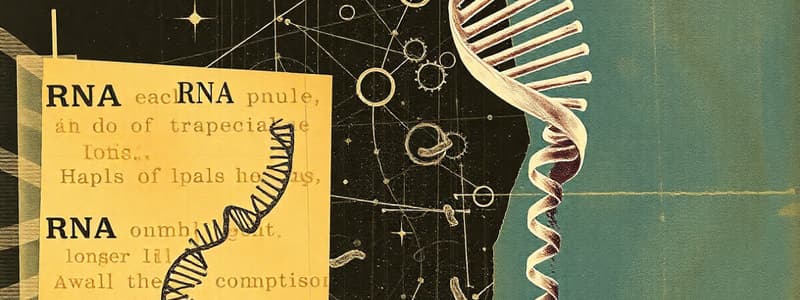Podcast
Questions and Answers
During transcription, which enzyme is responsible for synthesizing RNA from a DNA template?
During transcription, which enzyme is responsible for synthesizing RNA from a DNA template?
- Ribosome
- Ligase
- DNA polymerase
- RNA polymerase (correct)
A frameshift mutation always results in a silent mutation, where the amino acid sequence remains unchanged.
A frameshift mutation always results in a silent mutation, where the amino acid sequence remains unchanged.
False (B)
Describe the relationship between amino acids, polypeptides, and proteins.
Describe the relationship between amino acids, polypeptides, and proteins.
Amino acids are the monomers that make up polypeptides. Polypeptides are chains of amino acids linked by peptide bonds, and one or more polypeptides twisted, folded, and coiled into a unique shape forms a protein.
The codon AUG is special because it codes for the amino acid methionine and also serves as the ______ codon to initiate translation.
The codon AUG is special because it codes for the amino acid methionine and also serves as the ______ codon to initiate translation.
Match each type of RNA with its primary function in the cell.
Match each type of RNA with its primary function in the cell.
Flashcards
Key differences between RNA and DNA
Key differences between RNA and DNA
RNA contains ribose sugar, is single-stranded, uses uracil instead of thymine. DNA contains deoxyribose sugar, is double-stranded, and uses thymine.
Three Types of RNA
Three Types of RNA
mRNA carries genetic code, tRNA transfers amino acids, rRNA is a component of ribosomes.
Transcription Overview
Transcription Overview
Transcription is the process of creating RNA from a DNA template, happening in the nucleus, using RNA polymerase.
Amino Acids, Polypeptides, and Proteins
Amino Acids, Polypeptides, and Proteins
Signup and view all the flashcards
Translation Overview
Translation Overview
Signup and view all the flashcards
Study Notes
- RNA and DNA differ in three key aspects
- RNA is single-stranded, while DNA is double-stranded.
- RNA contains the sugar ribose, whereas DNA contains deoxyribose.
- RNA uses uracil (U) as a base, while DNA uses thymine (T).
- RNA and DNA share three similarities
- Both are nucleic acids.
- Both are composed of a sugar-phosphate backbone.
- Both contain the bases adenine, guanine, and cytosine.
Types of RNA
- Messenger RNA (mRNA) carries genetic information from DNA to the ribosomes.
- Transfer RNA (tRNA) brings amino acids to the ribosomes during protein synthesis.
- Ribosomal RNA (rRNA) is a component of ribosomes.
Importance of Proteins
- Proteins are crucial for various functions in the body.
- Enzymes catalyze biochemical reactions.
- Structural proteins provide support.
- Transport proteins carry molecules.
- Hormones coordinate bodily functions.
- Antibodies defend against foreign invaders.
Transcription
- Transcription is the process of synthesizing RNA from a DNA template.
- It occurs in the nucleus (eukaryotes) or cytoplasm (prokaryotes).
- RNA polymerase is the enzyme involved, and it binds to DNA and synthesizes a complementary RNA strand.
Amino Acids, Polypeptides, and Proteins
- Amino acids are the monomers that make up polypeptides and proteins.
- Polypeptides are chains of amino acids linked by peptide bonds.
- Proteins are functional molecules made of one or more polypeptides folded into a specific three-dimensional structure.
Genetic Code
- The genetic code is the set of rules by which information encoded in genetic material (DNA or RNA) is translated into proteins by living cells.
Codon
- A codon is a sequence of three nucleotides that codes for a specific amino acid or a stop signal during protein synthesis.
Codons and Amino Acids
- There are 64 different codons.
- There are 20 amino acids.
- AUG is a start codon that also codes for methionine.
- Stop codons signal the end of translation.
Translation
- Translation is the process of synthesizing a protein from an mRNA template.
- It occurs in the ribosomes.
- Key components include mRNA, tRNA, ribosomes, and amino acids.
- tRNA molecules bring specific amino acids to the ribosome based on the mRNA codon sequence.
Mutation
- A mutation is a change in the nucleotide sequence of DNA.
Point Mutation
- A point mutation is a change in a single nucleotide base.
- Substitutions replace one base with another.
- Insertions add a base.
- Deletions remove a base.
Frameshift Mutation
- A frameshift mutation is an insertion or deletion of nucleotides that shifts the reading frame.
Studying That Suits You
Use AI to generate personalized quizzes and flashcards to suit your learning preferences.




